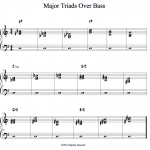In a previous video, we discussed learning the various major triads by playing them through the cycles of 4ths and 5ths. In this lesson, we will learn some ways to use these triads to build more complex chords.
The Concept:
Placing the root of a triad on some tone other than the bass note can lead to new chord sounds. This can be done with a number of shapes, such as the T4 and T3 shapes we discussed in another lesson. Today, we will discuss major triads used in this fashion. Since the triad on top has a different root than the bass note, there is a nice duality and color.
Since the triads used have three inversions, this allows three different voicings using each triad concept. Each of these can be chosen based on pitch range, top note, and voice-leading to other chords in the progression. This voice-leading is easily learned through the process of connecting the triads.
Major Triad Superimpositions
- Major triad based on the b3: this gives us a complete minor 7 chord. The triad tones consist of b3, 5 and b7. This is probably the most common triad over bass formula. An example would be Eb/C, or Eb major over a C bass.
- Major triad on the 5th: This yields 5th, 7th and 9th. This will typically be used as an open and transparent Major 7 voicing. It does not contain the 3rd, but this usually isn’t necessary to establish the quality in this case. If a minor 3rd is implied by context, this voicing can also be used as a Minor-Major sound. However, all other things being equal, the ear tends to group the major 7th degree with the major 3rd, even if it is absent. An example of this chord would be G/C.
- Major triad on b7: This creates a Sus7 voicing. The tones are b7, 9 and 4 .(11) This chord is sometimes called simply “11” on some chord charts, though typically an 11th is a tone that coexists with a 3rd rather than replacing it. An example of this voicing would be Bb/C.
- Major triad on 3: Placed on the major 3rd, a major triad will create a Major 7#5. This chord is sometimes called “+∆” as well. It is a bit less common due to its more dissonant quality, but is by no means rare. On C it would be E/C.
- Major triad on 9: Incomplete due to the lack of 3rd or 7th, this creates a “lydian” or #11 chord sound. Often it will be combined with a major triad or dominiant chord to create a colorful sound. Example: D/C
- Major Triad on 7: This creates a diminished triad with major 7, with the tones 7, b3, b5. While at first listen this sounds dissonant, under the correct conditions it can be a lovely chord. We will cover this color in another lesson. Example: B/C.
The Mental Training
It is important to associate the correct chord symbol with the keyboard application. One way to do this is to look at a chord chart with these types of chords, and then use the correct voicing. This creates an association between the visual stimulus and the keyboard shape, as well as connecting the sound to both.



Pingback: Triads Over Bass Part II: Add 11 | Randy Hoexter()